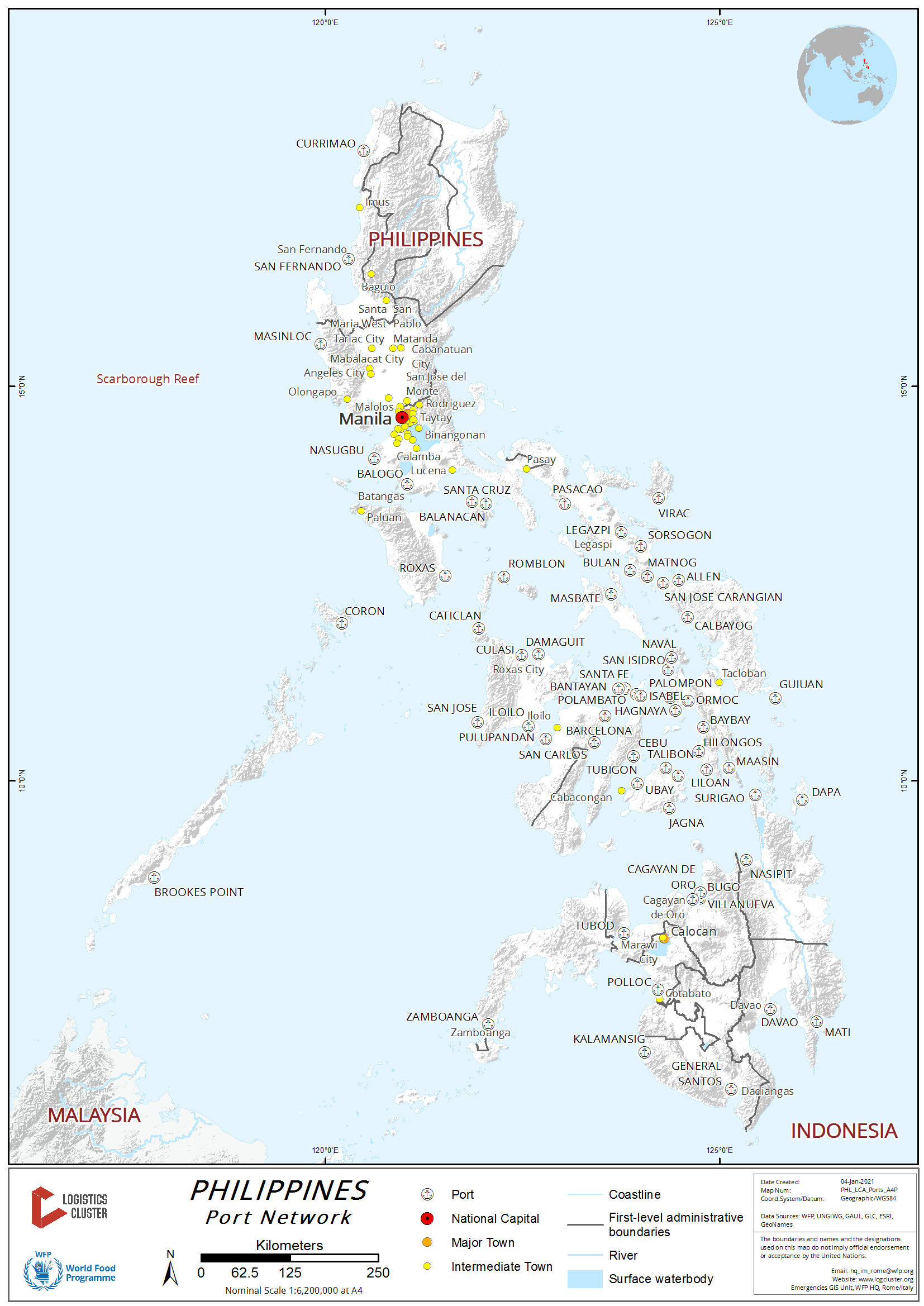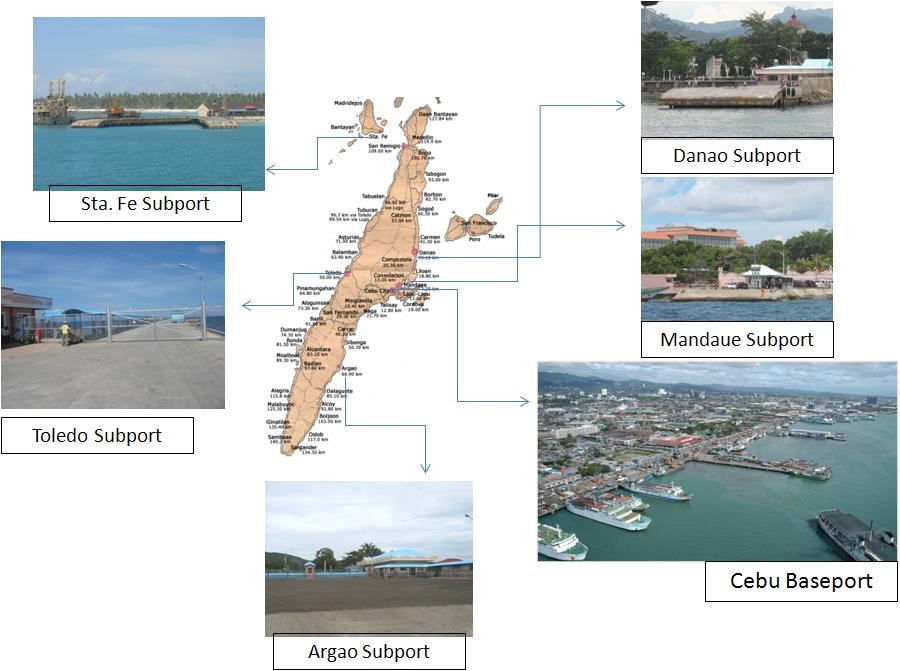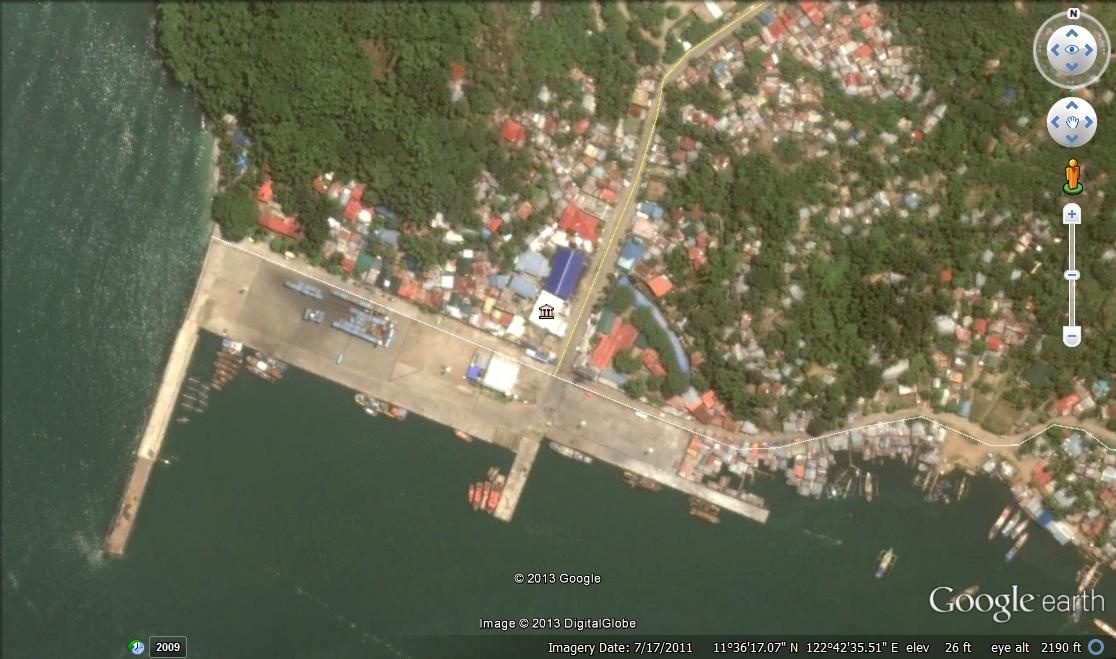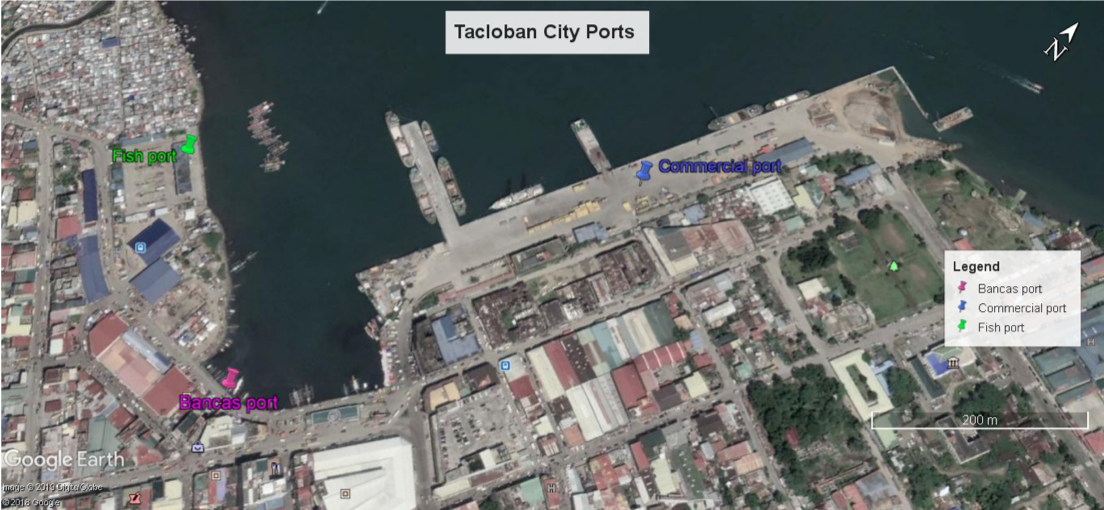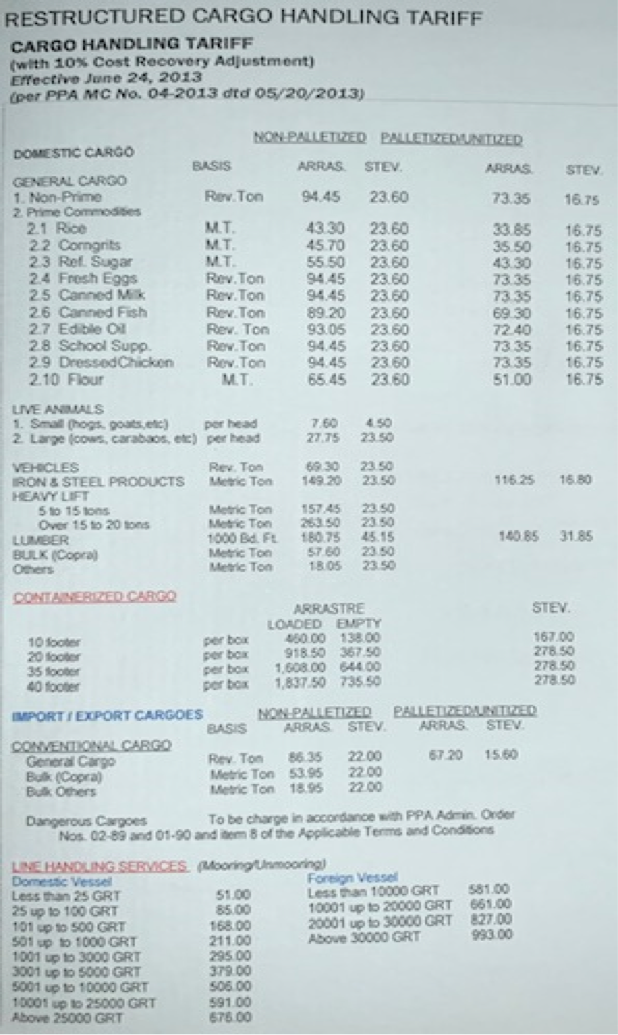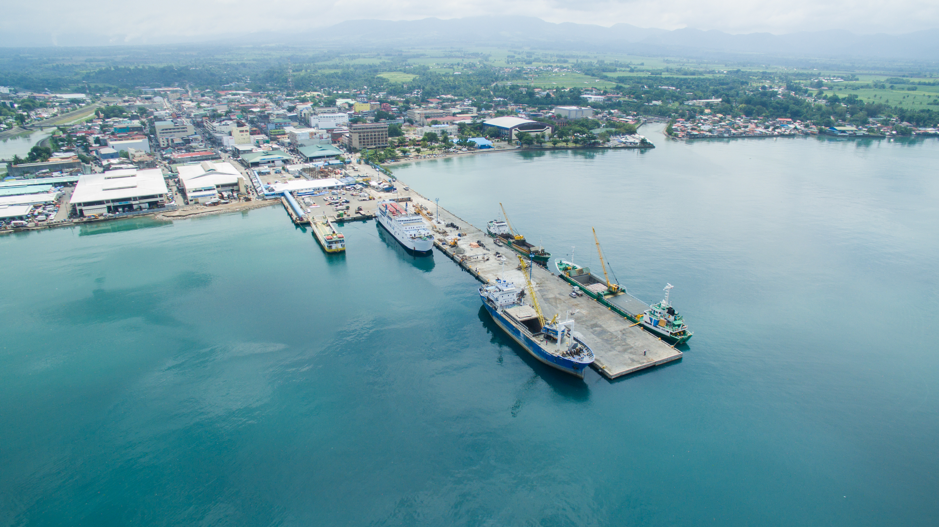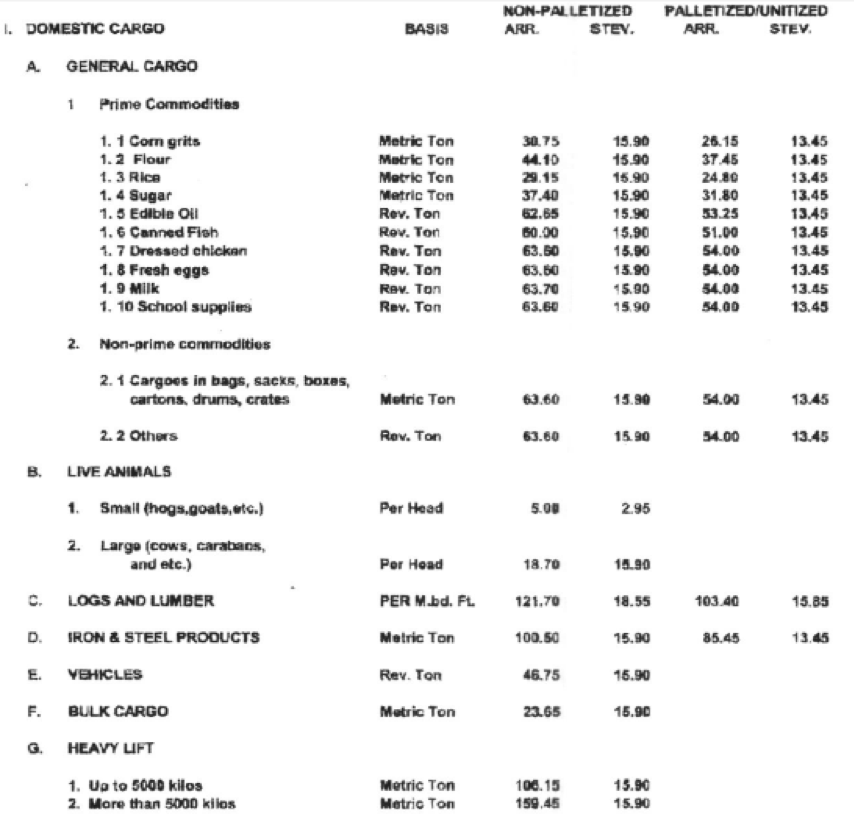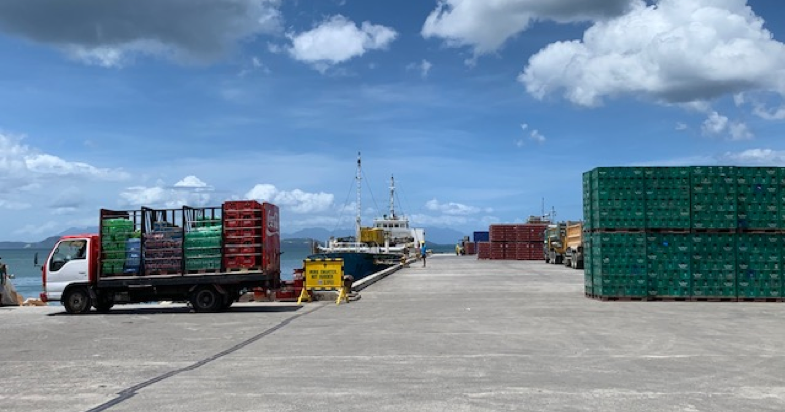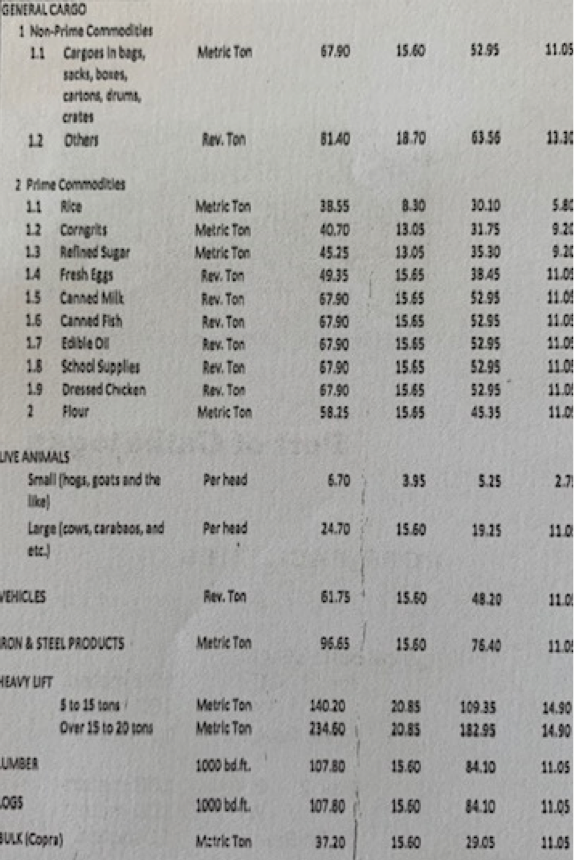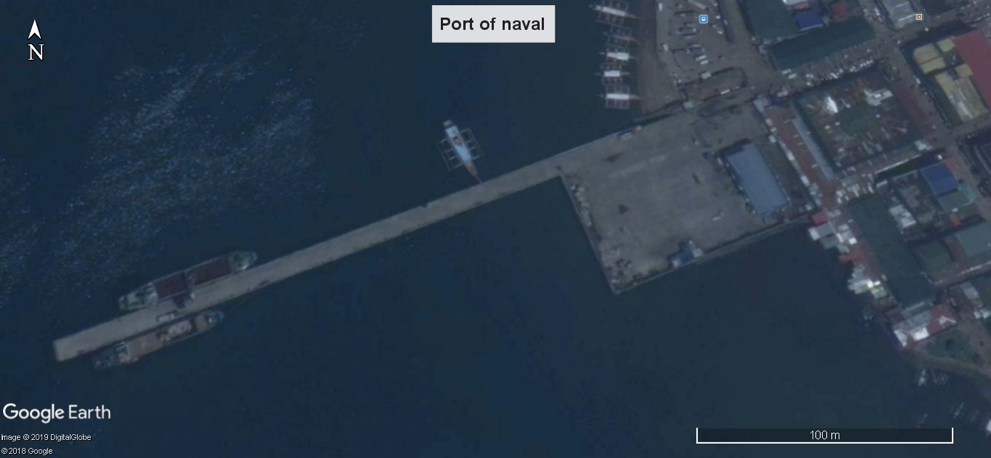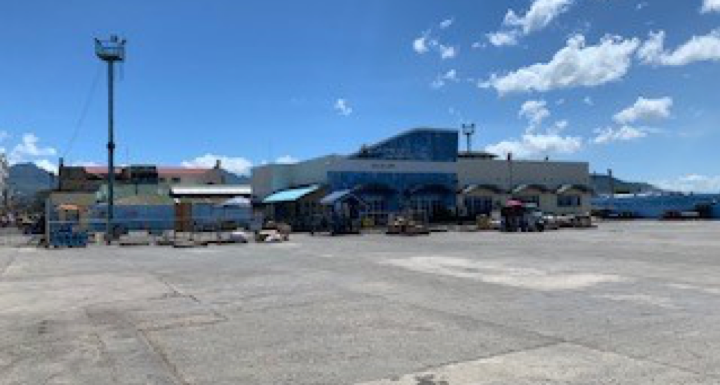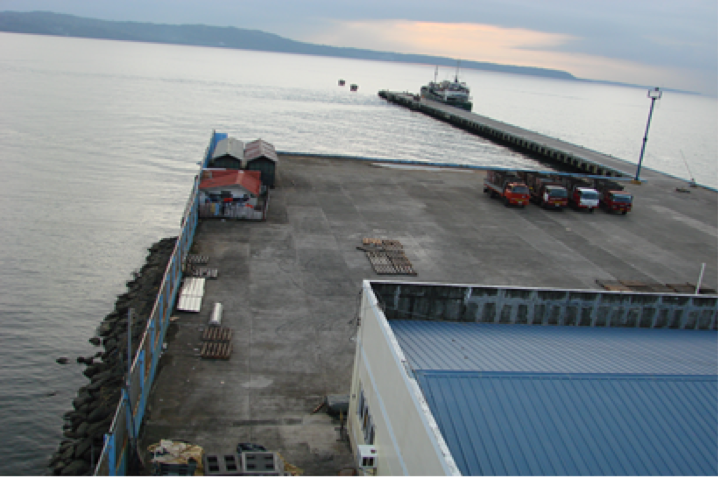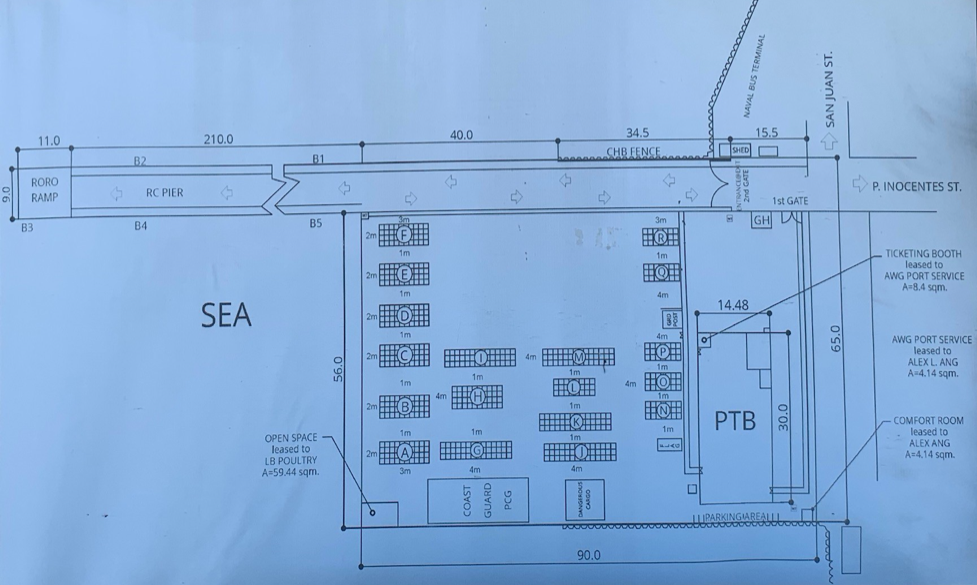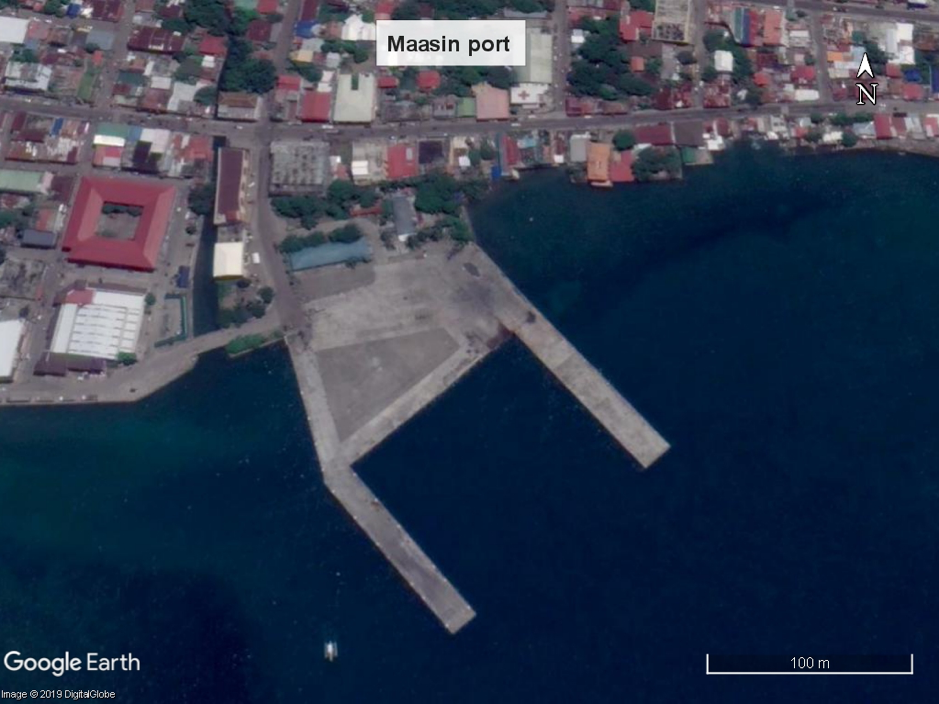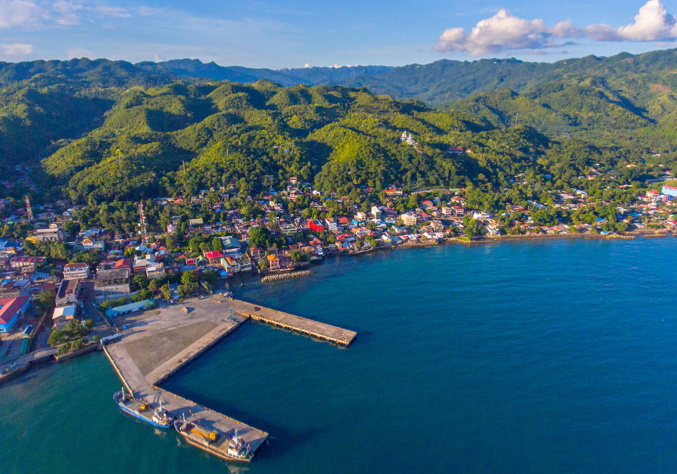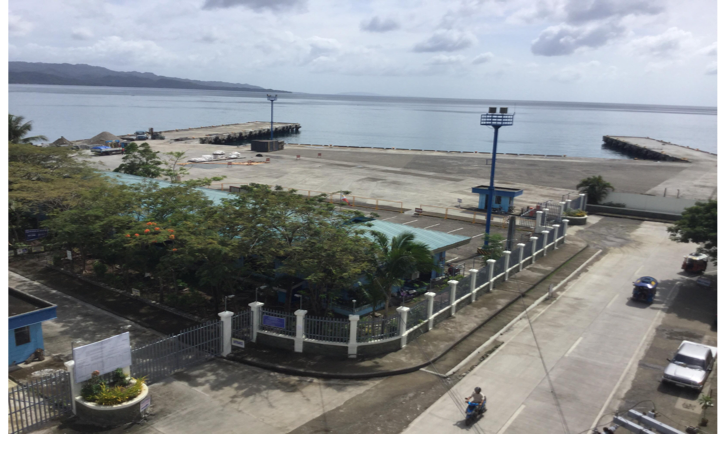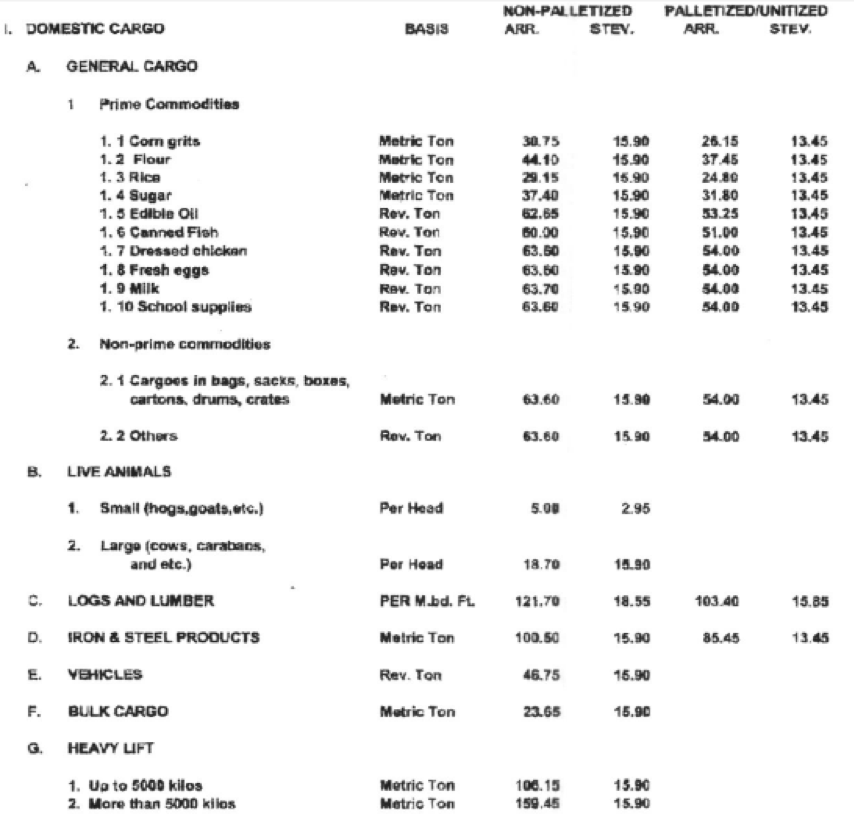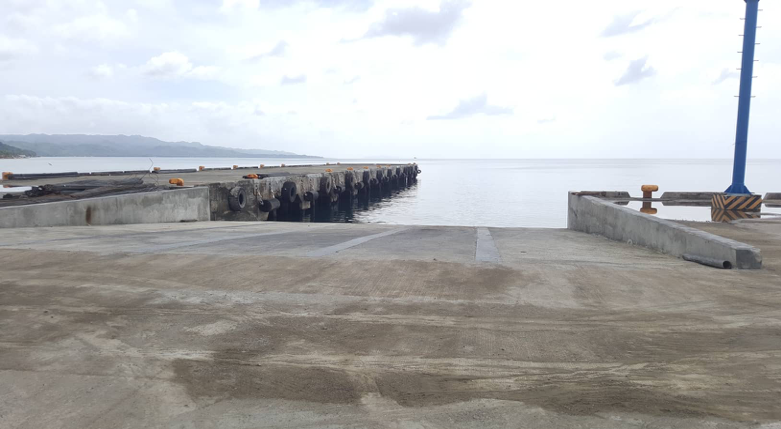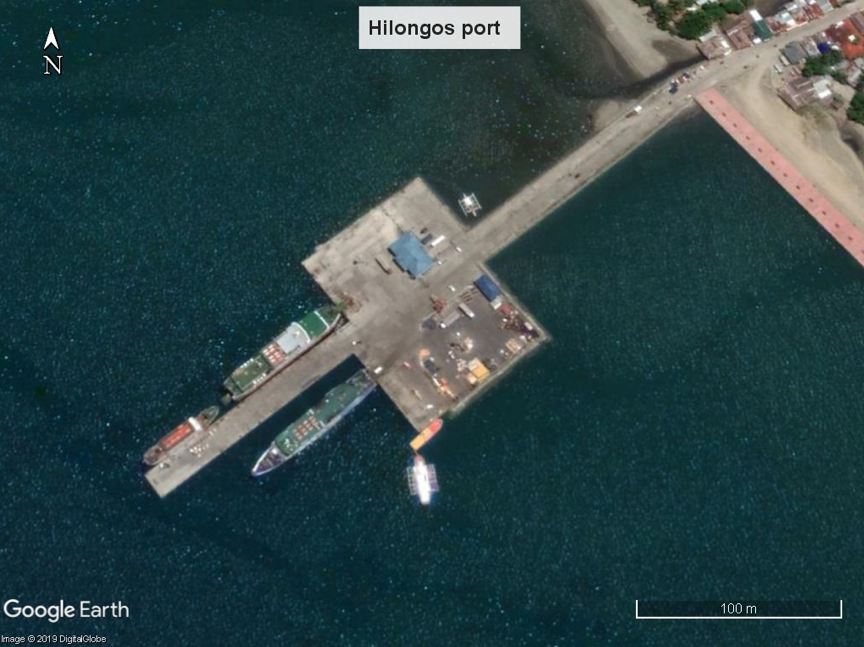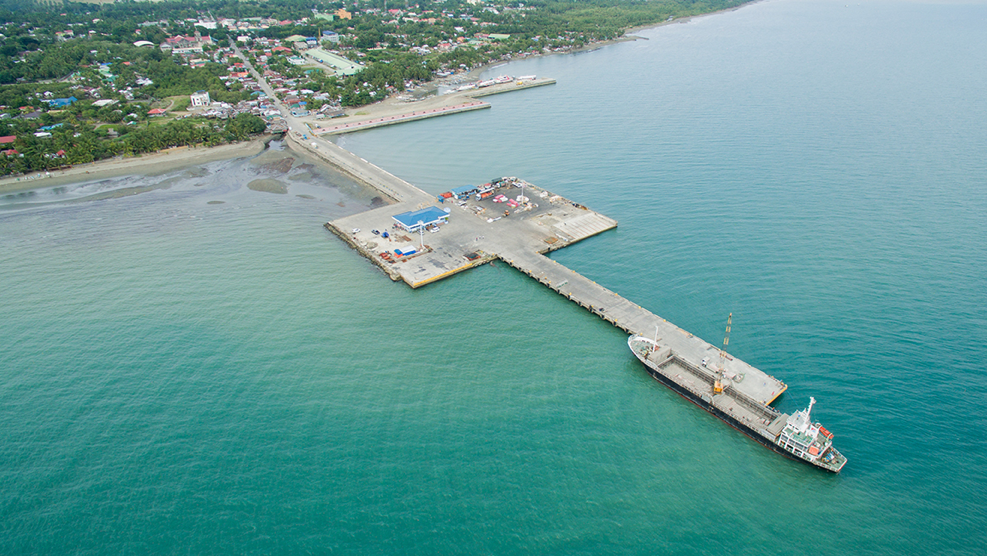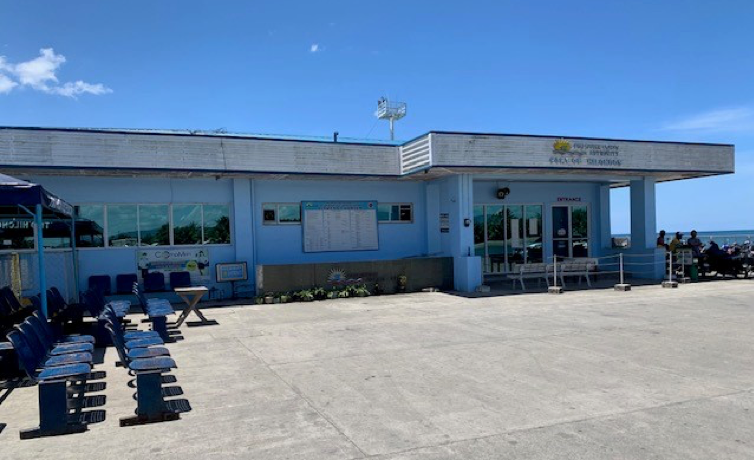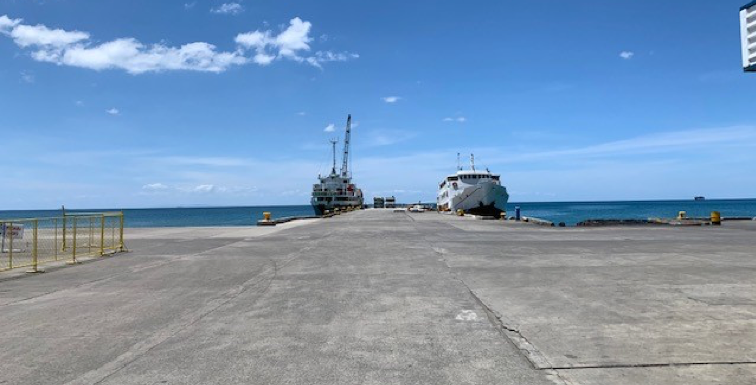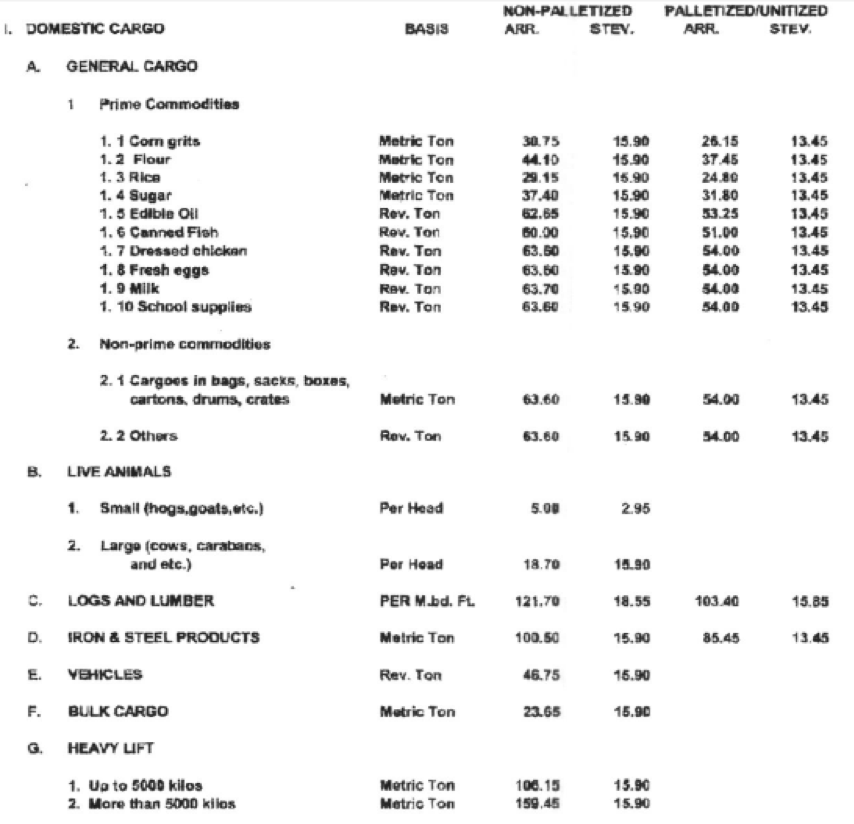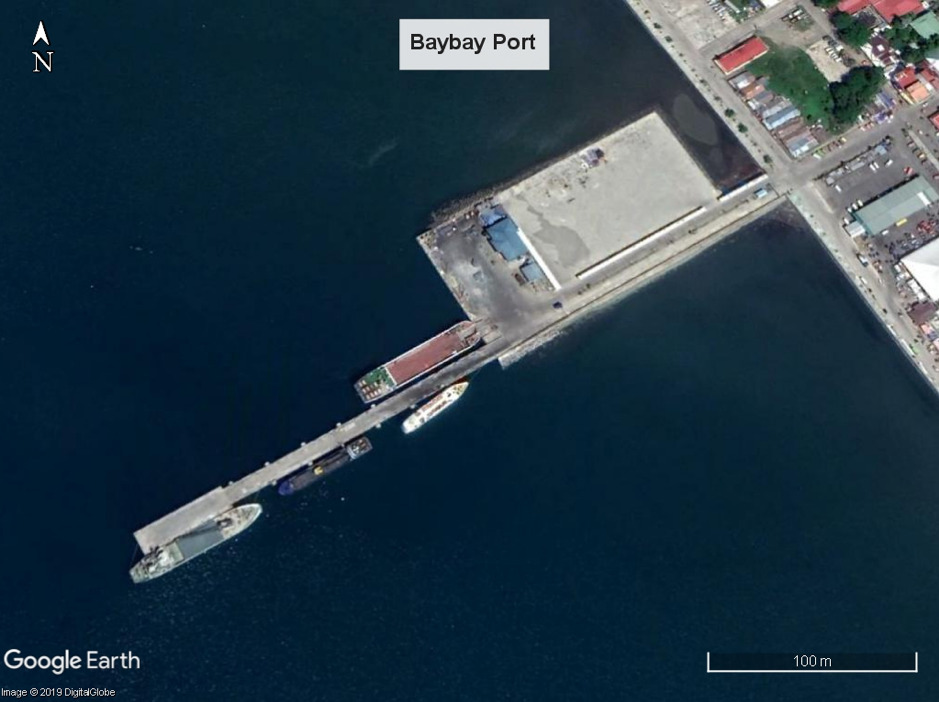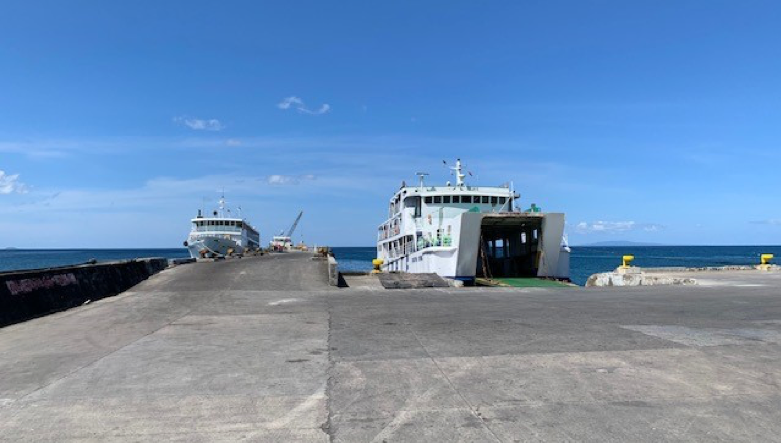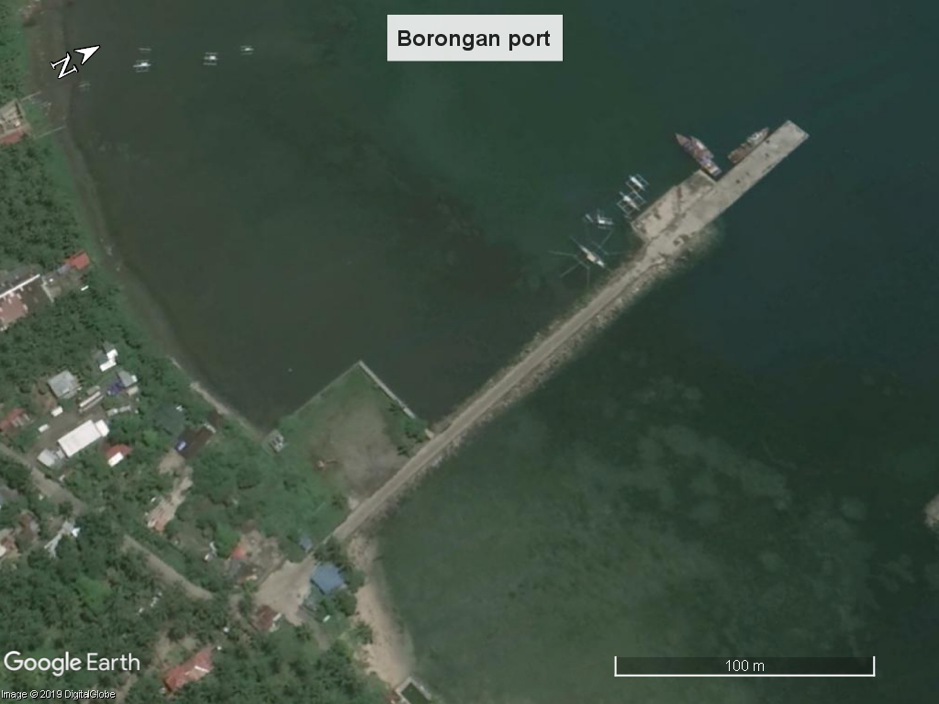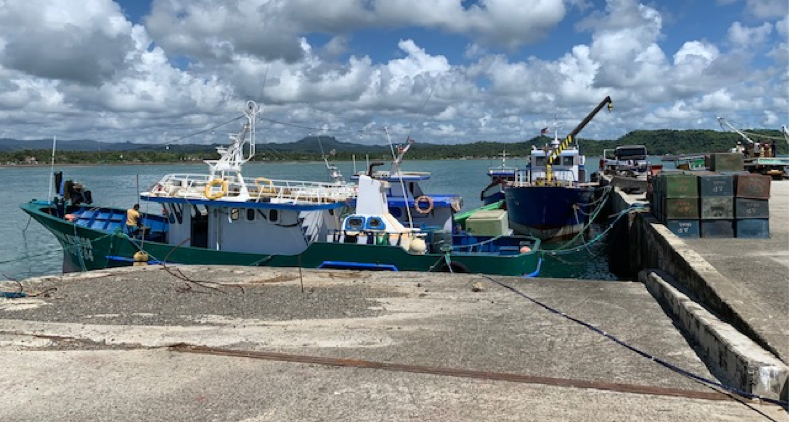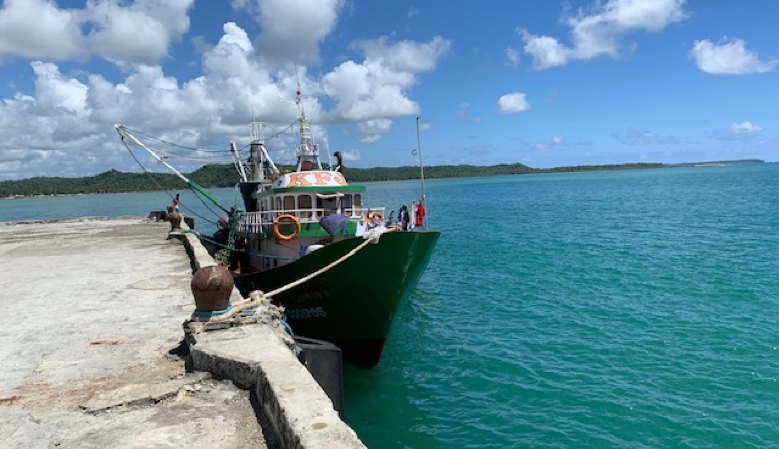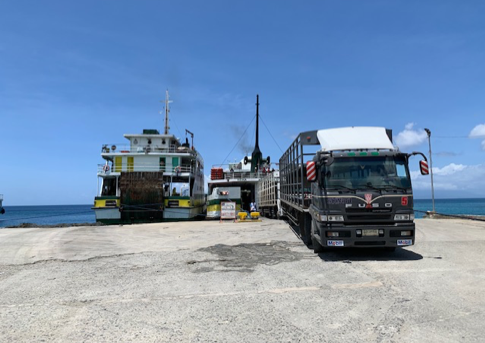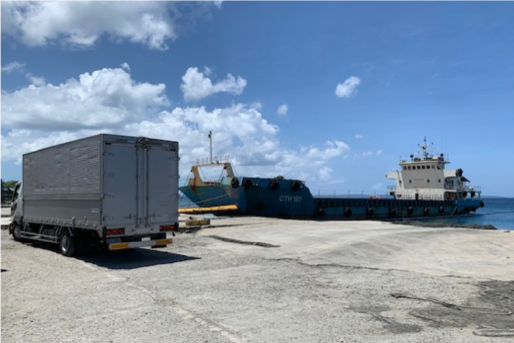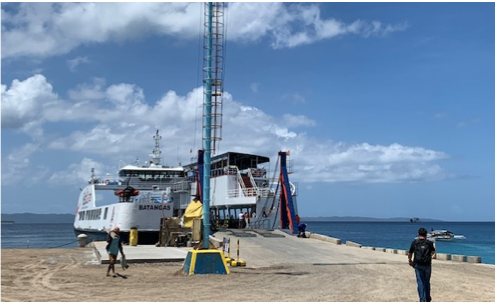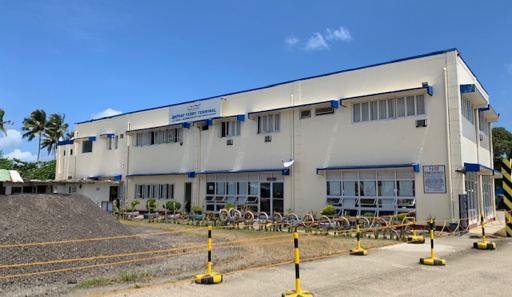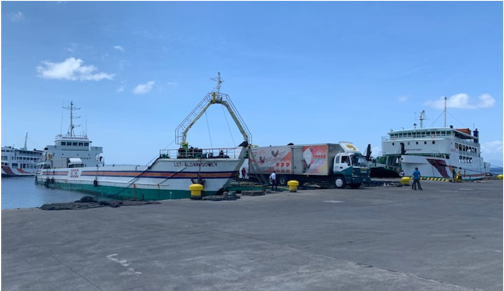2.1.2 Philippines - Visayas Port Assessment
The following pages contain information on ports in the Philippines, Visayas.
2.1.2.1 Philippines - Visayas Port of Cebu
Key port information can also be found at: Maritime Database Website information on Port of Cebu
Port Overview
The Cebu Port Network is composed of the Baseport and the Subports. Located in Cebu City, the Cebu Baseport is divided into Cebu International Port and Cebu Baseport Domestic Zone. The Subports are the secondary hubs or the management offices of the Cebu Port Authority strategically located in different areas of the entire province of Cebu. Under each subport are the outports - these are the ports under the smaller systems of subports. There are five Subport under the Cebu Port Network: Mandaue, Danao, Sta. Fe, Toledo, and Argao. Cebu baseport is suited at the city frontage between Cebu and Mactan Island, the port runs a total length of 4,202 meters (from International to Domestic Zone). The international zone has a length of 690 meters and the Domestic zone has 3,707 meters.
Source: Cebu Port Authority (publisher). http://www.cpa.gov.ph/index.php Date Last Accessed 09 Dec 2013
Port website: Cebu Port Authority Website
|
Port Location and Contacts |
|
|---|---|
|
Country |
Philippines |
|
Province or District |
Central Visayas |
|
Town or City (Closest location) with Distance (km) |
Name: Cebu km: n/a |
|
Port's Complete Name |
Port of Cebu |
|
Latitude |
10.3 |
|
Longitude |
123.8833 |
|
Managing Company or Port Authority (If more than one operator, break down by area of operation) |
Cebu Port Authority |
|
Management Contact Person |
+63.32.232-1461 to 63 |
|
Closest Airport and Frequent Airlines to / from International Destinations |
Airport Name: n/a Airlines: n/a |
Port Picture
Source: Cebu Port Authority (publisher). http://www.cpa.gov.ph/index.php Date Last Accessed 09 Dec 2013
Description and Contacts of Key Companies
The Cebu Port Authority (CPA) was created through the enactment of Republic Act No. 7621 signed on June 26, 1992 to specifically administer all ports located in Cebu Province, thus, effectively separating these ports from the Philippine Ports Authority (PPA) system. CPA began operations and officially took over all Cebu ports on January 1, 1996. The Cebu Port Authority missions includes to build, operate and maintain ports under its network and implement an integrated management systems aligned with internationally accepted standards and practices for operations, planning and development of ports within its territorial jurisdiction enhancing trade and commerce.
Source: Cebu Port Authority (publisher). http://www.cpa.gov.ph/index.php Date Last Accessed 09 Dec 2013
For information on Port of Cebu contact details, please see the following links:
Cebu Port Authority Contact Directory
4.3 Philippines Port and Waterways Company Contact List
Port Performance
For information on port performance figures, please see the following link:
Cebu Port Authority website information on Port Statistics
Discharge Rates and Terminal Handling Charges
For information on port Discharge Rates and Handling charges, please see the following link:
Cebu Port
Authority Webiste on Port Rates
Port Specifications and Facilities
For information on port specifications and facilities, please see the following link:
Cebu Port
Authority Website information on Port Services and
Facilities
Customs Guidance
For information on Philippines Port of Cebu Customs Guidance, please see the following links:
1.3 Philippines Customs Information
Cebu Port Authority Website information on Cebu Harbour Entry requirements
PLEASE NOTE: Following the response to Typhoon Haiyan (Yolanda) on 09 Nov 2013, additional Philippines Customs information is avalible and can be found in the following document:
Logistics Cluster Philippines Customs Snapshot 131114
In order to streamline the customs procedures for humanitarian organisations bringing relief good into the Philippines, a “One-Stop-Shop” has been established in Manila, Cebu and Naia. The Purpose of the “One-Stop-Shop” is to bring together in a single location the key staff, necessary for expediting customs clearances for humanitarian cargo, for the selected agencies including representatives of: the Department of Social Welfare and Development (DSWD), the Department of Health, The Bureau of Food and Drugs, the Ministry of Finance (MoF), and the Department of Foreign Affairs (DFA).
2.1.2.2 Philippines - Visayas Port of Roxas
PLEASE NOTE: THIS ASSESSMENT HAS BEEN CARRIED OUT FOLLOWING THE EMERGENCY RESPONSE TO TYPHOON HAIYAN (YOLANDA) ON 09 NOV 2013
The information given in the below assessment is correct as of 01 Dec 2013, however it may be suject to change at short notice.
It has been provided following the emergency response to Typhoon Haiyan (Yolanda) therefore the format of the assessment is presented differently from information provided for a non-emergency LCA.
|
Port Location and Contacts |
|
|---|---|
|
Country |
Philippines |
|
Province or District |
Capiz |
|
Town or City (Closest location) with Distance (km) |
Name: Roxas km: n/a |
|
Port's Complete Name |
Port of Roxas |
|
Latitude |
11.6046 |
|
Longitude |
122.7086 |
|
Managing Company or Port Authority (If more than one operator, break down by area of operation) |
n/a |
|
Management Contact Person |
Port Operations Manager: Mr. Al De Jesus 0906 947 1802 / 0947 890 4860 |
|
Closest Airport and Frequent Airlines to / from International Destinations |
Airport Name: n/a Airlines: n/a |
General Overview
| Main entrance | Hanging electricity cables, therefore non-passable for container trucks. |
|---|---|
| Road Entrance | Sometimes congested |
| Other comments | No congestion as confirmed by Port Manager |
Port Profile
Please note: The port can handle RORO / cargo ship, Passenger Ferries and Containers (10', 20', 40')
| Berth | Length / Comments |
|---|---|
| Old Wharf | 162.16m |
| New Wharf | 232.17m |
| Breakwater | 160.5m |
| Finger Pier | 62.75m x 12m |
|
RoRo Ramp 1 RoRo Ramp 2 |
1 - 15m x 12m 2 - 15m x 9m |
| Container Yard | 9,120m |
| Open Storage | 5,538m |
| PTB | 729m2 |
| Draft | 6.1m |
For information on the current Port of Roxas depths, please see the following diagrams:
Port Rates and Handling Charges
| Arrastre Fee | |
|---|---|
|
Charges Against Cargo |
Rate/RT or MT |
| General Cargo | 98.60 |
| Palletized | 76.80 |
| Sugar | 55.85 |
| Rice | 45.50 |
| Stevedoring Fees | |
|---|---|
| General Cargo | 19.50 |
| Palletized | 13.90 |
| Sugar | 19.50 |
| Rice | 19.50 |
| Stripping/Stuffing Fee | 398.50/Unit |
| Charges Against Vessel | |
|---|---|
| Mooring / Unmooring Fee | 487.05 |
Please Note:
- Dangerous Cargo e.g. Cement etc plus 25% to the Arrastre and Stevedoring Rate
- For unloading of RORO / cargo ship, WFP has to pay charges to port authorities as handling charges.
- For unloading / loading containers, the handler (M/s MORETA) has an official contract from the Government and is authorized to render services (cranes / forklifts, etc) for which he will be paid directly. No other handler can be on ground as per his contract.
- The port authority will waive off the port charges if a letter from the Government is presented.
- As it is humanitarian aid so no demurrage will be claimed.
Port Contacts
| Title | Name | Contact |
|---|---|---|
| Port Operations Manger | Mr. Al De Jesus |
0906 947 1802 0947 890 4860 |
Port Pictures
Port of Roxas RoRo Ramps:
Port of Roxas:
For additional photographs of Philippines Port of Roxas, please see the following links:
2.1.2.3 Philippines - Visayas Port of Isabel
PLEASE NOTE: THIS ASSESSMENT HAS BEEN CARRIED OUT FOLLOWING THE EMERGENCY RESPONSE TO TYPHOON HAIYAN (YOLANDA) ON 09 NOV 2013
The information given in the below assessment is correct as of 11 Dec 2013, however it may be suject to change at short notice.
It has been provided following the emergency response to Typhoon Haiyan (Yolanda) therefore the format of the assessment is presented differently from information provided for a non-emergency LCA.
Key port information can also be found at: Maritime Database Website information on Philippines Port of Isabel
Port Overview
The terminal suffered extensive damage during typhoon Yolanda.
PhilPhos is currently advising that they expect their terminal to
be back in operation earliest in March,2014. Meantime they are
prepared to consider alternative business such as Relief.
During a recent visit, one barge was discharging relief rice with a
shore crane hired from outside.
Port website: Philippines Port Authority Wesbite for Port of Isabel
For information on Philippines Port of Isabel Contact details, please see the following link:
4.2.3 Philippines Port and Waterways Company Contact List
|
Port Location and Contacts |
|
|---|---|
|
Country |
Philippines |
|
Province or District |
Leyte Island |
|
Town or City (Closest location) with Distance (km) |
Name: Ormoc km: 44 km west |
|
Port's Complete Name |
Port of Isabel |
|
Latitude |
10.91667 |
|
Longitude |
124.4333 |
|
Managing Company or Port Authority (If more than one operator, break down by area of operation) |
Philippine Ports Authority |
|
Management Contact Person |
Mr Raoul Port Operation manager |
|
Closest Airport and Frequent Airlines to / from International Destinations |
Airport Name: n/a Airlines: n/a |
Discharge Rates and Terminal Handling Charges
| Discharge Rates | |
|---|---|
| Per Hook (Depending on Vessel design) | Up to 500mt |
| Gears |
Max 2000mt per day |
Please Note:
- Nets are available,
- Terminal avails itself of labour through a contractor
| Costs | |
|---|---|
| Ex hold of the ship to stacked in Terminal WH | 150 Pesos per mt |
| Ex stack to on trucks | 5 Pesos per bags |
For additional rates and costs information, please contact Mr Cesar Banaag (Vice-President of Manufacturing)
Berthing Specifications
|
Berth |
Length (m) |
Comments |
|---|---|---|
|
1 |
280 m by 12.00m | For use to handle phosrocks |
|
2 |
180 m by 9.50 m | Berth that would be made available to Relief operations |
|
3 |
120 m by 8.00 m | n/a |
| 4 | 110 m by 7.00 m | n/a |
| 5 | 75 m by 5.00 m | n/a |
Please Note:
- There is NO shore gear available at the berths. GEARED vessels only.
- Short option to rent a mobile crane but to be checked long in advance of vessel’s arrival. Only valid for coasters and barges ,as discharge performance with a mobile crane would be insufficient to match speed required under charter contracts.
- Since this is a private Terminal, berth availability should checked directly their Port Operation manager Mr. Raoul
Customs Guidance
Customs is available in the Port of Isabel
For information on Philippines Customs Guidance please see the following links:
1.3 Philippines Customs Information
PLEASE NOTE: Following the response to Typhoon Haiyan (Yolanda) on 09 Nov 2013, additional Philippines Customs information is available and can be found in the following document:
Logistics Cluster Philippines Customs Snapshot 131114
In order to streamline the customs procedures for humanitarian organisations bringing relief good into the Philippines, a “One-Stop-Shop” has been established in Manila, Cebu and Naia. The Purpose of the “One-Stop-Shop” is to bring together in a single location the key staff, necessary for expediting customs clearances for humanitarian cargo, for the selected agencies including representatives of: the Department of Social Welfare and Development (DSWD), the Department of Health, The Bureau of Food and Drugs, the Ministry of Finance (MoF), and the Department of Foreign Affairs (DFA).
Port Security
Private company for gates, but presence of army inside warehousing compound
2.1.2.4 Philippines - Visayas Port of Tacloban
Port Overview
Strategically located at the heart of Eastern Visayas or Region 8, Tacloban City lies along the northeastern side of the island of Leyte. Tacloban`s location and accessibility have made the city the commercial, government and political hub of the region.
Bodies of water that surround the city are Panalaron Bay and Cancabato Bay. On its eastern shores is the San Juanico Strait - reputedly the narrowest navigable channel in the world. On the southern side the city is flanked by the waters of San Pedro Bay stretching towards Leyte Gulf.
Port website: www.ppa.com.ph
Key port information may also be found at: http://www.maritime-database.com/port.php?pid=475
|
Port Location and Contact |
|||||||||||
|
Country |
Philippines |
||||||||||
|
Region Province |
Region 8, Eastern Visayas Leyte |
||||||||||
|
Nearest Town or City with Distance from Port |
Tacloban |
||||||||||
|
Port's Complete Name |
Port of Tacloban |
||||||||||
|
Latitude |
11.248526 |
||||||||||
|
Longitude |
124.999924 |
||||||||||
|
Managing Company or Port Authority
|
Philippines Port Authority (PPA) Head Office of Port Management Office Eastern Leyte / Samar (PMOELS) |
||||||||||
|
Management Contact Person |
Mr. Emiliano M Esparaguera Port Manager 0533216704 |
||||||||||
|
Nearest Airport and Airlines with Frequent national Arrivals/Departures |
Tacloban Daniel Z. Romualdez Airport (9km)
|
||||||||||
Port Picture
Description and Contacts of Key Companies
Cargo handling services: Leyte Integrated Port Services Inc. (LIPSI)
Mr.Ignacio b. Malate
General Manager
Tel. 053 321-3641
Pilotage services: Tacloban Pilot Association
Capt. Ramon L. de Rama
Tel. 053 832-1006
Port security services: Lockheed Global Security and Investigation Services Inc. (LGSISI)
Mr. Noel Cajipo
Acting detachment commander
Ancillary external services can be arrange by contacting the port authorities:
- Bunkering
- Transport service
- Water supply
- Handling
- Cargo surveying
Port Performance
The sea is shallow along the San Juanico Strait. The port does not have navigational facilities for the vessels to enter the Tacloban City Port at night time or in the afternoon.
The northern channel passing by San Pedro bay is 5.6 m draft with a 120 feet (36.5m) clearance maximum due to the San Francisco bridge, while the southern channel is 4.8 m draft only.
The port is rarely congested and humanitarian cargo will be prioritized in case of relief operations.
|
Seasonal Constraints |
||
|
|
Occurs |
Time Frame |
|
Rainy Season |
Yes |
Most frequent during December and January |
|
Major Import Campaigns |
No |
n/a |
|
Other Comments |
Rainfalls and typhoons are throughout the year with no pronounced dry seasons. |
|
|
Handling Figures for 2018 |
|
|
Vessel Calls |
701 |
|
Container Traffic (TEUs) |
54,087 |
|
Handling Figures Bulk and Break Bulk for 2018 |
|
|
Bulk (MT) |
n/a |
|
Break bulk (MT) |
505’557 |
Discharge Rates and Terminal Handling Charges
Berthing Specifications
|
Type of Berth |
Quantity |
Length (m) |
Maximum Draft (m) |
Comments |
|
Conventional Berth |
Pier Warf |
287 750 |
7m 7 m |
Cast Iron mooring bollards, T head 25T capacity |
Port Handling Equipment
The port equipment belongs to the LIPSI. They use to rent additional equipment (mobile cranes, forklifts) from the shipping companies when they have a shortage. These equipment are habitually staying at the port and could be rented if necessary to speed up the offloading in case of relief operations.
|
Equipment |
Available |
Total Quantity and Capacity Available |
Comments on Current Condition and Actual Usage |
|
Dockside Crane |
No |
n/a |
n/a |
|
Container Gantries |
No |
n/a |
n/a |
|
Mobile Cranes |
Yes |
50 MT |
Good condition |
|
Reachstacker |
No |
n/a |
n/a |
|
RoRo Tugmaster (with Trailer) |
No |
n/a |
n/a |
|
Grain Elevator with Bagging Machines |
No |
n/a |
n/a |
|
Transtainer |
No |
n/a |
n/a |
|
Forklifts |
Yes |
1 x 15 MT 1 x 10 MT 1 x 7 MT 1 x 5 MT 3 x 3 MT |
Good condition |
Container Facilities
There are no containers facilities, the containers are offloaded with a ship/mobile crane and stored on an open space.
|
Facilities |
10/20/40 ft |
|
Container Facilities Available |
None |
|
Container Freight Station (CFS) |
None |
|
Refrigerated Container Stations |
None |
|
Other Capacity Details |
Open container yard: 2,094 m2 |
|
Daily Take Off
Capacity |
72 units regardless the size |
|
Number of Reefer
Stations |
None |
|
Emergency Take-off Capacity |
n/a |
|
Off take Capacity of Gang
Shift |
24 units regardless the size |
Customs Guidance
A customs office stand just behind the port, they can process import/export clearance. If all documents are in order, vessels clearances take about 1 hour and all payments have to be done by bank wire only.
The custom office is open from Monday to Friday with a permanence on the weekend. Office hours are from 8.00 to 17.00.
District Collector Office; Bocportoftacloban@yahoo.fr , 09175272351 / 0535306939
For more information on customs in Philippines, please see the following link: 1.3 Philippines Customs Information
Terminal Information
Multipurpose Terminal
The conventional berth is suitable to receive all different types of cargo: bagged cargo, break-bulk, containers.
There are 3 Ro-Ro ramps:
Ro-Ro ramp 1: 18m
Ro-Ro ramp 2: 10.5m
Ro-Ro ramp 3: 10.5m
Grain and Bulk Handling
Some bulk cargos can be handled (liquid bulk and dry bulk). Generally molasses for liquid bulk and copra for dry bulk cargoes.
Main Storage Terminal
There are no warehouses available in the port enclosure. All goods are either picked up directly on vessels arrival and loaded on trucks or stored on open areas.
|
Storage Type |
Number of Storage Facilities |
Area (m2) |
|
Refrigerated Cargo |
None |
n/a |
|
Container yard |
1 open space |
2’094 m2 |
|
General Cargo |
1 open space |
4’459 m2 |
|
Transit shed |
1 open space |
540 m2 |
Stevedoring
Stevedoring activities are provided by a private company contracted by the port authorities. Please refer to “Description and Contacts of Key Companies” above.
Hinterland Information
All items are moved out of the port by trucks contracted independently. Temporary vehicle pass are provided at the main gate by the port police division.
Port Security
The port is fenced; there are security guards at the main gate and in the terminal building. The coastguards have an office outside the port perimeter and do regular patrol in the area. Manual and wheeled fire extinguisher are available, if needed, fire trucks can be called from the municipality.
There are 7 high mast steel tower equipped with halogen flood light.
First aid shelters are disseminated along the port with some staff trained on emergency services.
|
Security |
|
|
ISPS Compliant |
Yes |
|
Current ISPS Level (Level 1 = Normal, Level 2 = Heightened, Level 3 = Exceptional) |
Level 1 |
|
Police Boats |
Yes (coastguards) |
|
Fire Engines |
No |
2.1.2.5 Philippines Visayas Port of Ormoc
Port Overview
Ormoc port is the head office of the Port Management Office of Western Leyte / Biliran (PMOWLB). It is the second port of Region 8 and its location make it a good alternative to Tacloban port for cargo coming from Cebu.
The port of Ormoc can cater to both small foreign and domestic vessels, and receive containerized cargoes as well as bulk and breakbulk cargoes. The main inbound cargoes are cement and the outbound commodities are copra. Cement from Cebu and copra/s are bound for Jimenez.
Port website: www.ppa.com.ph
Key port information may also be found at: http://www.maritime-database.com/port.php?pid=3956
|
Port Location and Contact |
|||||||||||
|
Country |
Philippines |
||||||||||
|
Region Province |
Region 8, Eastern Visayas Leyte |
||||||||||
|
Nearest Town or City with Distance from Port |
Ormoc |
||||||||||
|
Port's Complete Name |
Port of Ormoc |
||||||||||
|
Latitude |
11.002685 |
||||||||||
|
Longitude |
124.606696 |
||||||||||
|
Managing Company or Port Authority
|
Philippines Ports Authority (PPA) Head Office of the Port Management Office of Western Leyte / Biliran (PMOWLB) – Head Office in Ormoc |
||||||||||
|
Management Contact Person |
Mr. Manuel A. Boholano Port Manager 0535614663 |
||||||||||
|
Nearest Airport and Airlines with Frequent national Arrivals/Departures |
Tacloban “Daniel Z. Romualdez” Airport (109 km)
|
||||||||||
Port Picture
Description and Contacts of Key Companies
Cargo Handling: New Eagle Arrastre Services, Inc.(NEASI)
Bldg.A Public Market
Real St., Ormoc City
Tel.no. 561-2168/255-3726
Mr. Ram Capahi
COO/Comptroller
Pilotage: Tacloban Harbor Pilots Association (THPA)
Port Security: Lockheed Global Security and Investigation Services
Inc. (LGSISI)
Other port related services:
- Bunkering:Petrologistics
- Ship Repair Facilities: IDHI, Albuera, Leyte
Port Performance
The port is often congested but there is a port expansion project. The average waiting time before berthing depends upon the availability of the berthing space but can be up to 3 days. The channel draft of Ormoc port is 11.7 m. The limitation of the vessels is 91 m length and 7m draft maximum.
|
Seasonal Constraints |
||
|
|
Occurs |
Time Frame |
|
Rainy Season |
Yes |
Most frequent during December and January |
|
Major Import Campaigns |
No |
n/a |
|
Other Comments |
Rainfalls and typhoons are throughout the year with no pronounced dry seasons. |
|
|
Handling Figures for 2018 |
|
|
Vessel Calls |
5,442 |
|
Container Traffic (TEUs) |
4,857 TEUs |
|
Handling Figures Bulk and Break Bulk for 2018 |
|
|
Bulk (MT) |
41,597.90 MT |
|
Break bulk (MT) |
368,807.02 MT |
Discharge Rates and Terminal Handling Charges
Berthing Specifications
|
Type of Berth |
Quantity |
Length (m) |
Maximum Draft (m) |
Comments |
|
Conventional Berth |
9 |
649 m |
9 m |
n/a |
Berth details:
Draft; as of August 2015 survey
|
Berth # |
Length (m) |
Draft (m) |
|
1 |
63 |
2 |
|
2 |
65 |
5.46 |
|
3 |
65 |
5.46 |
|
4 |
90 |
5.91 |
|
5 |
30 |
9 |
|
6 |
69 |
7.46 |
|
7 |
69 |
5.74 |
|
8 |
67 |
4.21 |
|
9 |
15 |
4.15 |
|
10 |
70 |
3.2 |
Port Handling Equipment
Port equipment is managed by the authorised cargo handling operator, the New Eagle Arrastre Services, Inc. (NEASI).
|
Equipment |
Available |
Total Quantity and Capacity Available |
Comments on Current Condition and Actual Usage |
|
Dockside Crane |
No |
n/a |
n/a |
|
Container Gantries |
No |
n/a |
n/a |
|
Mobile Cranes |
No |
n/a |
n/a |
|
Reachstacker |
No |
n/a |
n/a |
|
RoRo Tugmaster (with Trailer) |
No |
n/a |
n/a |
|
Grain Elevator with Bagging Machines |
No |
n/a |
n/a |
|
Transtainer |
No |
n/a |
n/a |
|
Forklifts |
Yes |
Forklifts 3.5 Tons = 3 Forklifts 4.0 Tons = 1 Forklifts 5.0 Tons = 1 Forklifts 15 Tons = 1 |
Good condition |
RORO Facilities: 2 RORO ramps, dimension 15 m.
1 fast craft ramp
Container Facilities
There are no containers facilities, the containers are offloaded with a ship/mobile crane directly loaded to the trucks. There are not yet containers yards put it is in includes in the future development,
|
Facilities |
10/20/40 ft |
|
Container Facilities Available |
None |
|
Container Freight Station (CFS) |
None |
|
Refrigerated Container Stations |
None |
|
Other Capacity Details |
None |
|
Daily Take Off
Capacity |
168 units regardless the size |
|
Number of Reefer
Stations |
None |
|
Emergency Take-off Capacity |
n/a |
|
Off take Capacity of Gang
Shift |
56 |
Customs Guidance
There is a custom office outside the port, they can process import/export clearance. If all documents are in order, vessels clearances take about 1 hour and all payments have to be done by bank wire only.
The custom office is open from Monday to Friday with a permanence on the weekend. Office hours are from 8.00 to 17.00.
For more information on customs in Philippines, please see the following link: 1.3 Philippines Customs Information
Terminal Information
Multipurpose Terminal
The conventional berth is suitable to receive all different types of cargo: bagged cargo, break-bulk or containers.
Containerized cargoes operations (loading and unloading) are done with using the ship's crane.
There are 2 x 15m width RoRo ramps.
Grain and Bulk Handling
Some bulk cargos can be handle (liquid bulk and dry bulk). Generally molasses for liquid bulk and copra for dry bulk cargoes.
Main Storage Terminal
There are no warehouses available in the port enclosure. All goods are either picked up directly on vessels arrival and loaded on trucks or stored on open areas.
|
Storage Type |
Number of Storage Facilities |
Area (m2) |
|
General Cargo |
3 |
|
Stevedoring
Stevedoring activities are provided by the authorized cargo handling operator, the New Eagle Arrastre Services, Inc. (NEASI).
Port Security
The port is fenced; there are security guards at the main gate and in the terminal building. The coastguards have an office outside the port perimeter and do regular patrol in the area. Manual and wheeled fire extinguisher are available, if needed, fire trucks can be called from the municipality.
|
Security |
|
|
ISPS Compliant |
Yes |
|
Current ISPS Level (Level 1 = Normal, Level 2 = Heightened, Level 3 = Exceptional) |
Level 1 |
|
Police Boats |
No |
|
Fire Engines |
No |
2.1.2.6 Philippines Port of Catbalogan
Port Overview
Situated in Eastern Samar, the port of Catbalogan is the main port for cargo of the three provinces of Samar Island. There are regular shipping lines to Cebu carrying mainly cement, construction material, animal feeds and other general cargos in break bulk.
During the Yolanda typhoon emergency response, it played a key role in the supply of relief items to Tacloban city.
Port website: www.ppa.com.ph
Key port information may also be found at: http://www.maritime-database.com/port.php?pid=3916
|
Port Location and Contact |
|||||||||||
|
Country |
Philippines |
||||||||||
|
Region Province |
Region 8, Eastern Visayas Samar |
||||||||||
|
Nearest Town or City with Distance from Port |
Catbalogan |
||||||||||
|
Port's Complete Name |
Port of Catbalogan |
||||||||||
|
Latitude |
11.774260 |
||||||||||
|
Longitude |
124.879266 |
||||||||||
|
Managing Company or Port Authority
|
Philippines Port Authority (PPA) Under supervision of Port Management Office Eastern Leyte / Samar (PMOELS) – Head Office in Tacloban |
||||||||||
|
Management Contact Person |
Ildifonso A. Quilitano PPA Division Manager 09219848490 |
||||||||||
|
Nearest Airport and Airlines with Frequent International Arrivals/Departures |
Tacloban Daniel Z. Romualdez Airport : 112 km
|
||||||||||
Port Picture
Description and Contacts of Key Companies
Cargo handling services: Leyte Integrated Port Services, INC. (LIPSI)
M. Ignacio B. Malate
General Manager
055 251-5483
Pilotage service: Catbalogan Pilotage District
Capt. Enriquito Y. Cahatol
09277642333
Security: Lockheed Global Security and Investigation Services Inc. (LGSISI)
Port Performance
Catbalogan port is rarely congested. When it happens, the vessels can wait up to two days maximum at anchorage. In such situation, the vessels carrying humanitarian cargos would be prioritized in case of emergency.
|
Seasonal Constraints |
||
|
|
Occurs |
Time Frame |
|
Rainy Season |
Yes |
Most frequent during December and January |
|
Major Import Campaigns |
No |
n/a |
|
Other Comments |
Rainfalls and typhoons are throughout the year with no pronounced dry seasons. |
|
|
Handling Figures for 2018 |
|
|
Vessel Calls |
1704 |
|
Container Traffic (TEUs) |
n/a |
|
Handling Figures Bulk and Break Bulk for 2018 |
|
|
Bulk (MT) |
n/a |
|
Break bulk (MT) |
513,183 |
Discharge Rates and Terminal Handling Charges
Berthing Specifications
|
Type of Berth |
Length (m) |
Maximum Draft (m) |
|
Pier 1 |
E 102 m W 102 m |
5 m |
|
Pier 2 |
E 108 m W 108 m |
5 m |
Port Handling Equipment
The port handling is done by the Leyte Integrated Port Services, INC. (LIPSI). They have four gangs of 12 staffs able to discharge an average of 21 MT per hour.
|
Equipment |
Available |
Total Quantity and Capacity Available |
Comments on Current Condition and Actual Usage |
|
Dockside Crane |
No |
n/a |
n/a |
|
Container Gantries |
No |
n/a |
n/a |
|
Mobile Cranes |
No |
n/a |
n/a |
|
Reachstacker |
No |
n/a |
n/a |
|
RoRo Tugmaster (with Trailer) |
No |
n/a |
n/a |
|
Grain Elevator with Bagging Machines |
No |
n/a |
n/a |
|
Transtainer |
No |
n/a |
n/a |
|
Forklifts |
Yes |
1 x 2.5 MT 1 x 4 MT |
Good condition |
Customs Guidance
Not available.
Terminal Information
Multipurpose Terminal
The conventional berth is suitable to receive bagged and break-bulk cargos.
There are 2 Ro-Ro ramps:
Ro-Ro ramp pier 1: 11m
Ro-Ro ramp pier 2: 11m
Main Storage Terminal
One open space and two warehouses are available.
|
Storage Type |
Number of Storage Facilities |
Area (m2) |
|
Refrigerated Cargo |
None |
n/a |
|
General Cargo |
Transit shed 1 Transit shed 2 Opening area |
648 m2 1170 m2 640 m2 |
Hinterland Information
All items are moved out of the port by trucks contracted independently by the cargo owners.
Port Security
The port is fenced; there are security guards at the main gate and in the terminal building. The coastguards have an office outside the port perimeter and do regular patrol in the area. Manual and wheeled fire extinguisher are available, if needed, fire trucks can be called 24/24 from the municipality.
|
Security |
|
|
ISPS Compliant |
Yes |
|
Current ISPS
Level |
Level 1 |
|
Police Boats |
Yes |
|
Fire Engines |
No |
2.1.2.7 Philippines Visayas Port of Naval
Port Overview
The port of Naval is the main port serving the Biliran province. Mainly used for passengers traveling to/from Cebu and the islands surrounding the area such as Maripipi or Higatangan. In 2018, 2,400 passengers have transited from Naval port.
Coming from Cebu, the main cargos coming in are cement, aggregate/construction material, fertilizers (in big bags or sacs), and few general goods such as rice, corn in break bulk. Copra is the only product transiting out of the port, there are no regular or seasonal schedule, it mainly depends on the market price.
Bunkering is not common but can be arranged on demand.
Port website: www.ppa.com.ph
Key port information may also be found at: https://www.maritime-database.com/
|
Port Location and Contact |
|||||||||||
|
Country |
Philippines |
||||||||||
|
Region and Province |
Biliran (Region 8, Eastern Visayas) |
||||||||||
|
Nearest Town or City with Distance from Port |
Naval |
||||||||||
|
Port's Complete Name |
Naval Port |
||||||||||
|
Latitude |
11.560233 |
||||||||||
|
Longitude |
124.391277 |
||||||||||
|
Managing Company or Port Authority
|
Philippines Ports Authority (PPA) Under the supervision of the Port Management Office of Western Leyte / Biliran (PMOWLB) – Head Office in Ormoc |
||||||||||
|
Management Contact Person |
Reyselle J.Gaviola Port Manager 0535009676 |
||||||||||
|
Nearest Airport and Airlines with Frequent National Arrivals/Departures |
Tacloban Daniel Z. Romualdez Airport (120 km)
|
||||||||||
Port Picture
Description and Contacts of Key Companies
Stevedoring: AWG Port Services (AWGPS)
Mr. Alex Lim Ang
General Manager
053 500-9617
Security: Lockheed Global Security and Investigation Services Inc. (LGSISI)
Port Performance
The Naval port is a small port serving the Biliran province only, which is the less populated in the Region 8. Never congested, vessels transporting relief cargos would be prioritised anyway in case of emergency.
The average cargo transiting per month is 1,800 mt.
There is no equipment to receive containers or heavy equipment. There is a possibility of renting a crane and other equipment outside the port but it is preferable to contract ships with cranes.
| Seasonal Constraints | ||
|
|
Occurs |
Time Frame |
|
Rainy Season |
Yes |
Most frequent during December and January |
|
Major Import Campaigns |
No |
n/a |
|
Other Comments |
Rainfalls and typhoons are throughout the year with no pronounced dry seasons. |
|
|
Handling Figures for 2018 |
|
|
Vessel Calls |
1014 |
|
Container Traffic (TEUs) |
N/A (ceased operation last 2017 for .50 TEU of 10 footer container) |
|
Handling Figures Bulk and Break Bulk for 2018 |
||
|
Bulk (MT) |
Inbound (aggregates) 53,067.78 MT |
Outbound (copra) 14,260.38 MT |
|
Break bulk (MT) |
Inbound (General Cargo) 6,879.008 MT |
Outbound (General Cargo) 70,698.433 MT |
Discharge Rates and Terminal Handling Charges
Berthing Specifications
|
Berth no. |
Quantity |
Length (m) |
Maximum Draft (m) |
|
Conventional Berthing area |
1 |
300 m |
4 m |
There is a total of 5 berths:
- Berth 1 is used for the Bancas (local made boats)
- Berth 2 is the deeper and generally used for the vessels transporting copra
- Berth 3 Ro-Ro
- Berth 4 is used for the Cebu’s regular ferries
- Berth 5 is habitually not used (draft is only 2.2m)
Port Handling Equipment
|
Equipment |
Available |
Total Quantity and Capacity Available |
Comments on Current Condition and Actual Usage |
|
Dockside Crane |
No |
n/a |
n/a |
|
Container Gantries |
No |
n/a |
n/a |
|
Mobile Cranes |
No |
n/a |
n/a |
|
Reachstacker |
No |
n/a |
n/a |
|
RoRo Tugmaster (with Trailer) |
No |
n/a |
n/a |
|
Grain Elevator with Bagging Machines |
No |
n/a |
n/a |
|
Transtainer |
No |
n/a |
n/a |
|
Forklifts |
Yes |
3 x 3.4 MT |
Good condition |
Container Facilities
Not available
Customs Guidance
Not available, only national transport.
Terminal Information
Multipurpose Terminal
The terminal is a passenger terminal. The cargos are discharged and loaded directly on trucks or stored on an open space; however, the owners are asked to pick up their goods within the day.
There is a 9m large Ro-Ro ramps at the extremity of the berth.
Grain and Bulk Handling
Not available.
Main Storage Terminal
|
Storage Type |
Number of Storage Facilities |
Area (m2) |
|
General / bagged Cargo |
1 open space |
1904 m2 |
|
Marshalling area |
1 open space |
2300 m2 |
Stevedoring
The cargo activities are not common but a private company provides stevedoring services. They can hire manual labour on demand; it is recommended to contact them before coming.
Port Security
The port is fenced; there are security guards at the main gate and in the terminal building. The coastguards have an office outside the port and do regular patrol in the area. Manual and wheeled fire extinguisher are available, if needed, fire trucks can be called from the municipality.
|
Security |
|
|
ISPS Compliant |
Yes |
|
Current ISPS Level (Level 1 = Normal, Level 2 = Heightened, Level 3 = Exceptional) |
Level 1 |
|
Police Boats |
Yes, coast guards |
|
Fire Engines |
No |
2.1.2.8 Philippines Visayas Port of Maasin
Port Overview
Maasin is the first chartered city in the Province of Southern Leyte, Region VIII. The port strategically faces Bohol Island and Canigao Channelin the northeast and opens up to the Mindanao Sea southward. This port serves vessels plying to Cebu City.
Commercial consists mainly of agricultural products such as copra and other commercial and industrial products coming from Cebu and Mindanao such cement, feeds, flour, rice and some steel or construction products.
Port website: www.ppa.com.ph
Key port information may also be found at: http://www.maritime-database.com/port.php?pid=3948
|
Port Location and Contact |
|||||||||||
|
Country |
Philippines |
||||||||||
|
Region Province |
Region 8, Eastern Visayas Southern Leyte |
||||||||||
|
Nearest Town or City with Distance from Port |
Maasin |
||||||||||
|
Port's Complete Name |
Port of Maasin |
||||||||||
|
Latitude |
10.131290 |
||||||||||
|
Longitude |
124.841361 |
||||||||||
|
Managing Company or Port Authority
|
Philippines Ports Authority (PPA) Under the supervision of the Port Management Office of Western Leyte / Biliran (PMOWLB) – Head Office in Ormoc |
||||||||||
|
Management Contact Person |
Me Joeniet M. Docena Officer-In-Charge / Sr. Terminal Operations Officer Phone: (053) 570-9812 pmowlb_maasin@yahoo.com.ph |
||||||||||
|
Nearest Airport and Airlines with Frequent National Arrivals/Departures |
Tacloban Daniel Z. Romualdez Airport : 178 km
|
||||||||||
Port Picture
Description and Contacts of Key Companies
Cargo Handling: Panaon Arrastre Service, Inc. (PASI-Maasin Branch)
Alfredo O. Bantug, Jr.
Branch Manager
Phone: (053) 381-2973
Security: Lockheed Global Security and Investigation Services Inc. (LGSISI)
Port Performance
| Seasonal Constraints | ||
|
|
Occurs |
Time Frame |
|
Rainy Season |
Yes |
Most frequent during December and January |
|
Major Import Campaigns |
No |
n/a |
|
Other Comments |
Rainfalls and typhoons are throughout the year with no pronounced dry seasons. |
|
|
Handling Figures for 2018 |
|
|
Vessel Calls |
515 |
|
Container Traffic (TEUs) |
In-137.5 / Out-140.50 |
|
Handling Figures Bulk and Break Bulk for 2018 |
||
|
Bulk (MT) |
Inbound (aggregates) 23,601.18 MT |
Outbound (copra) 20,387.12 MT |
|
Break bulk (MT) |
Inbound (General Cargo) 68,976.55 MT |
Outbound (General Cargo) 1,698.38 MT |
Discharge Rates and Terminal Handling Charges
Berthing Specifications
|
Type of Berth |
Quantity |
Length (m) |
Maximum Draft (m) |
Comments |
|
Conventional Berth |
6 |
420 m |
6 m |
Domestic cargoes only |
Berth details:
Pier 1: 102m x 18m
Pier 2 :105m x 15m
Ro-Ro ramp: 15m x 15m
Wharf: 102m
Controlling draft along berth: 6m
Port Handling Equipment
The port cargoes are handled through duly authorized Cargo Handling Operator, PANAON ARRASTRE SERVICES, INC. (PASI-MAASIN) using forklift equipment with gang complement deployed by the cargo handling operator.
|
Equipment |
Available |
Total Quantity and Capacity Available |
Comments on Current Condition and Actual Usage |
|
Dockside Crane |
No |
n/a |
n/a |
|
Container Gantries |
No |
n/a |
n/a |
|
Mobile Cranes |
No |
n/a |
n/a |
|
Reachstacker |
No |
n/a |
n/a |
|
RoRo Tugmaster (with Trailer) |
No |
n/a |
n/a |
|
Grain Elevator with Bagging Machines |
No |
n/a |
n/a |
|
Transtainer |
No |
n/a |
n/a |
|
Forklifts |
Yes |
1 x 3 MT 1 x 5 MT |
Good condition |
Container Facilities
None.
Terminal Information
Multipurpose Terminal
The terminal is suitable for bagged cargos. They are unloaded through a semi-mechanized scheme using vessel cranes with gang complement deployed by cargo handling operators
Bulk cargoes such as copra are contained in boxes being loaded to the vessel through the its crane equipment.
There is a RORO ramp, dimension: 15 X 15 meters and a marshalling area of 2,300 m2 for the vehicles.
Grain and Bulk Handling
Not available.
Main Storage Terminal
|
Storage Type |
Number of Storage Facilities |
Area (m2) |
|
Refrigerated Cargo |
None |
n/a |
|
General Cargo |
Open area |
1904 |
Stevedoring
Stevedoring services are also being provided through the same cargo handling operator, the Panaon Arrastre Services, Inc. (PASI)
Hinterland Information
Delivery of cargoes is also being undertaken by the Cargo Handling Operator (CHO)-PASI but most cargoes are being withdrawn by the cargo owners using their own/rented trucks or vehicles. Cargoes are being transferred from the port’s stacking area to tail end of truck using the forklift equipment provided by the CH operator.
Port Security
The port is fenced; there are security guards at the main gate and in the terminal building. The coastguards have an office outside the port and do regular patrol in the area. Manual and wheeled fire extinguisher are available, if needed, fire trucks can be called from the municipality.
The port has also newly installed Baggage X-Ray Machine Equipment and a Walk-Thru Metal Detector.
|
Security |
|
|
ISPS Compliant |
Yes |
|
Current ISPS Level (Level 1 = Normal, Level 2 = Heightened, Level 3 = Exceptional) |
Level 1 |
|
Police Boats |
Yes |
|
Fire Engines |
No |
2.1.2.9 Philippines Visayas Port of Hilongos
Port Overview
Hilongos is the second busiest port in the western coast of Leyte after Ormoc.
There are regular ferry lines to Cebu 4 times a day and to Ubay once a day.
Cargo vessels are calling the port regularly to supply cement, fertilizer, floor and feeding products for livestock while the only commodity going out is copra.
Bunkering is possible on demand but unusual as the prices in Cebu are cheaper.
Port website: http://www.ppa.com.ph/
Key port information may also be found at https://www.maritime-database.com/port.php?pid=3929
|
Port Location and Contact |
|||||||||||
|
Country |
Philippines |
||||||||||
|
Region Province |
Region 8, Easter Visayas Leyte |
||||||||||
|
Nearest Town or City with Distance from Port |
Hilongos |
||||||||||
|
Port's Complete Name |
Port of Hilongos |
||||||||||
|
Latitude |
10.369507 |
||||||||||
|
Longitude |
124.742072 |
||||||||||
|
Managing Company or Port Authority
|
Philippines Ports Authority (PPA) Under the supervision of the Port Management Office of Western Leyte / Biliran (PMOWLB) – Head Office in Ormoc |
||||||||||
|
Management Contact Person |
Melvin D. Narajos Port Manager 09178880781 |
||||||||||
|
Nearest Airport and Airlines with Frequent National Arrivals/Departures |
Tacloban Daniel Z. Romualdez Airport : 140 km
|
||||||||||
Port Picture
Description and Contacts of Key Companies
Cargo handling:
San Vicente Arrastre and Stevedoring Services (SVASS)
09178880781
Security: Lockheed Global Security and Investigation Services Inc. (LGSISI)
Port Performance
The port is never congested and vessels carrying relief items would be prioritised in case of emergency.
The handling capacities are very limited, it is highly recommended to charter either vessels with cranes for heavy cargo or RoRo vessels for light cargos and wheeled equipment.
Navigational approach is 14.5 km along Canigao channel (8m draft).
|
Seasonal Constraints |
||
|
|
Occurs |
Time Frame |
|
Rainy Season |
Yes |
Most frequent during December and January |
|
Major Import Campaigns |
No |
n/a |
|
Other Comments |
Rainfalls and typhoons are throughout the year with no pronounced dry seasons. |
|
|
Handling Figures for 2018 |
|
|
Vessel Calls |
1710 |
|
Container Traffic (TEUs) |
n/a |
|
Handling Figures Bulk and Break Bulk for 2018 |
|
|
Bulk (MT) |
n/a |
|
Break bulk (MT) |
447’580 MT |
Discharge Rates and Terminal Handling Charges
Berthing Specifications
|
Type of Berth |
Quantity |
Length (m) |
Maximum Draft (m) |
|
Conventional Berth |
1 pier |
161,5 x 15 m |
6 m |
|
RoRo ramps |
3 ramps |
9 x 11 m |
6 m |
Port Handling Equipment
Handling equipment are owned, maintained and managed by SVASS.
|
Equipment |
Available |
Total Quantity and Capacity Available |
Comments on Current Condition and Actual Usage |
|
Dockside Crane |
No |
n/a |
n/a |
|
Container Gantries |
No |
n/a |
n/a |
|
Mobile Cranes |
No |
n/a |
n/a |
|
Reachstacker |
No |
n/a |
n/a |
|
RoRo Tugmaster (with Trailer) |
No |
n/a |
n/a |
|
Grain Elevator with Bagging Machines |
No |
n/a |
n/a |
|
Transtainer |
No |
n/a |
n/a |
|
Forklifts |
Yes |
1 x 5 MT 1x 20 MT |
Good condition |
Container Facilities
Not available.
Customs Guidance
Not available.
Terminal Information
Multipurpose Terminal
Most of the cargo are coming with passengers travelling on the ferries, by vehicles with Ro-Ro vessels, or in bags with crane ships. The terminal is not equipped to receive bulk or containerised commodities.
3 Ro-Ro ramps available, dimensions: 9m x 11m.
Grain and Bulk Handling
Not available.
Main Storage Terminal
There are no warehouses available at the port.
|
Storage Type |
Number of Storage Facilities |
Area (m2) |
|
Refrigerated Cargo |
n/a |
n/a |
|
General Cargo |
Open storage area |
2000 |
Stevedoring
Very limited capacity, provided by SVASS. Possibility to rent crane or other equipment from outside, by calling the port authorities in advance.
Hinterland Information
All items are moved out of the port by trucks contracted independently by the cargo owners.
Port Security
The port is fenced; there are security guards at the main gate and in the terminal building. The coastguards have an office outside the port and do regular patrol in the area. Manual and wheeled fire extinguisher are available, if needed, fire trucks can be called from the municipality.
|
Security |
|
|
ISPS Compliant |
Yes |
|
Current ISPS Level (Level 1 = Normal, Level 2 = Heightened, Level 3 = Exceptional) |
Level 1 |
|
Police Boats |
Yes (coastguards) |
|
Fire Engines |
No |
2.1.2.10 Philippines Visayas Port of Baybay
Port Overview
Baybay is the second city of the western coast of Leyte but its port is less developed. There are regular ferry lines to Cebu twice a day and few cargo vessels coming depending the demand.
Generally, the cargo vessels come to supply cement, fertilizer or animal feeding product from Cebu while the only commodities going out are copra product.
Bunkering is possible on demand but unusual as the prices in Cebu are cheaper.
Port website: www.ppa.com.ph
Key port information may also be found at: http://www.maritime-database.com/port.php?pid=4931
|
Port Location and Contact |
|||||||||||
|
Country |
Philippines |
||||||||||
|
Region Province |
Region 8, Eastern Visayas Leyte |
||||||||||
|
Nearest Town or City with Distance from Port |
Baybay |
||||||||||
|
Port's Complete Name |
Port of Baybay |
||||||||||
|
Latitude |
10.674779 |
||||||||||
|
Longitude |
124.796334 |
||||||||||
|
Managing Company or Port Authority
|
Philippines Ports Authority (PPA) Under the supervision of the Port Management Office of Western Leyte / Biliran (PMOWLB) – Head Office in Ormoc |
||||||||||
|
Management Contact Person |
Marissa M.Florendo Acting Division Manager 09167555027 |
||||||||||
|
Nearest Airport and Airlines with Frequent International Arrivals/Departures |
Tacloban Daniel Z. Romualdez Airport: 104 km
|
||||||||||
Port Picture
Description and Contacts of Key Companies
Cargo handling services:
Leyte Integrated Port Services Inc. (LIPSI)
053 321-3641
Port security services:
Lockheed Global Security and Investigation Services Inc. (LGSISI)
Port Performance
The port is never congested and vessels carrying relief items would be prioritised in case of emergency.
|
Seasonal Constraints |
||
|
|
Occurs |
Time Frame |
|
Rainy Season |
Yes |
Most frequent during December and January |
|
Major Import Campaigns |
No |
n/a |
|
Other Comments |
Rainfalls and typhoons are throughout the year with no pronounced dry seasons. |
|
|
Handling Figures for 2018 |
|
|
Vessel Calls |
586 |
|
Container Traffic (TEUs) |
n/a |
|
Handling Figures Bulk and Break Bulk for 2018 |
|
|
Bulk (MT) |
126,713 MT |
|
Break bulk (MT) |
n/a |
Discharge Rates and Terminal Handling Charges
Berthing Specifications
|
Type of Berth |
Quantity |
Length (m) |
Maximum Draft (m) |
Comments |
|
Conventional Berth |
7 |
482 m |
5 m |
Only domestic cargos |
Berth details:
Pier 1: 204 m x 13 m
Ro-Ro ramp: 13 m
Wharf: 74 m
Controlling draft along berth: 3 to 5 m
Port Handling Equipment
|
Equipment |
Available |
Total Quantity and Capacity Available |
Comments on Current Condition and Actual Usage |
|
Dockside Crane |
No |
n/a |
n/a |
|
Container Gantries |
No |
n/a |
n/a |
|
Mobile Cranes |
No |
n/a |
n/a |
|
Reachstacker |
No |
n/a |
n/a |
|
RoRo Tugmaster (with Trailer) |
No |
n/a |
n/a |
|
Grain Elevator with Bagging Machines |
No |
n/a |
n/a |
|
Transtainer |
No |
n/a |
n/a |
|
Forklifts |
Yes |
1 x 2,5 MT 1x 3.5 MT 1 x 6 MT |
Good condition |
Container Facilities
Not available.
Customs Guidance
Not available.
Terminal Information
Multipurpose Terminal
Most of the cargo are coming with passengers travelling on the ferries, by vehicles with Ro-Ro vessels, or in bags with crane ships. The terminal is not equipped to receive bulk or containerised commodities.
There is a Ro-Ro ramp: berth No.7
Grain and Bulk Handling
Not available.
Main Storage Terminal
There are no warehouse available at the port.
|
Storage Type |
Number of Storage Facilities |
Area (m2) |
|
Refrigerated Cargo |
None |
n/a |
|
General Cargo |
Open storage area |
2’000 |
|
Marshalling area |
Open place |
7’086 |
Stevedoring
Stevedoring services are provided by the Leyte Integrated Port Services Inc (LIPSI). Cargo are unloaded through a semi-mechanized scheme using vessel cranes with gang complement deployed by cargo handling operators).
Bulk cargoes such as copra are contained in boxes being loaded to the vessel through the its crane equipment.
Hinterland Information
All items are moved out of the port by trucks contracted independently. Temporary vehicle pass are provided at the main gate by the port police division.
Port Security
The port is fenced; there is security guards at the main gate and in the terminal building. The coastguards have an office outside the port perimeter and do regular patrol in the area. Manual and wheeled fire extinguisher are available, if needed, fire trucks from the municipality can be called.
|
Security |
|
|
ISPS Compliant |
Yes |
|
Current ISPS Level (Level 1 = Normal, Level 2 = Heightened, Level 3 = Exceptional) |
Level 1 |
|
Police Boats |
Yes (coastguards) |
|
Fire Engines |
No |
2.1.2.11 Philippines Visayas Port of Borongan
Port Overview
The Port of Borongan a small national port and can accommodate only medium-draft sea vessels.
The port is only serving the city of Borongan and few surrounding islands; it is mainly called by vessels coming from Cebu with cement and by fishing boats based in the city. Other commodities usually come by road from Tacloban.
Bunkering is possible on demand.
Port website: www.ppa.com.ph
Key port information may also be found at: http://www.maritime-database.com/port.php?pid=3897
|
Port Location and Contact |
|||||||||||
|
Country |
Philippines |
||||||||||
|
Region Province |
Region 8, Easter Visayas, Eastern Samar |
||||||||||
|
Nearest Town or City with Distance from Port |
Borongan |
||||||||||
|
Port's Complete Name |
Port of Borongan |
||||||||||
|
Latitude |
11°36'33.15"N |
||||||||||
|
Longitude |
125°26'43.66"E |
||||||||||
|
Managing Company or Port Authority
|
Philippines Port Authorities (PPA) Under supervision of the Port Management Office Eastern Leyte / Samar (PMOELS) – Head office in Tacloban |
||||||||||
|
Management Contact Person |
Me. Fe Perosa Officer in charge 09552013157 |
||||||||||
|
Nearest Airport and Airlines with Frequent National Arrivals/Departures |
Tacloban “Daniel Z. Romualdez” Airport: 200km
|
||||||||||
Port Picture
Description and Contacts of Key Companies
Cargo handling:
Mr. Gil Estrobo
Company owner
09287139555
Security:
Lockheed Global Services
Port Performance
Activities are very limited with only few cargo vessels per year. The port is mainly used by fishing boats; they are asked to leave when a cargo vessel is calling the port.
|
Seasonal Constraints |
||
|
|
Occurs |
Time Frame |
|
Rainy Season |
Yes |
Most frequent during December and January |
|
Major Import Campaigns |
No |
n/a |
|
Other Comments |
Rainfalls and typhoons are throughout the year with no pronounced dry seasons. |
|
|
Handling Figures for 2018 |
|
|
Vessel Calls |
10 |
|
Container Traffic (TEUs) |
n/a |
|
Handling Figures Bulk and Break Bulk for 2018 |
|
|
Bulk (MT) |
n/a |
|
Break bulk (MT) |
4,229.06 MT |
Discharge Rates and Terminal Handling Charges
Arrastre: Php 5 / sac
Stevedoring: Php 13 / MT
Berthing Specifications
|
Type of Berth |
Quantity |
Length (m) |
Maximum Draft (m) |
|
Conventional Berth |
1 |
45 m |
6 m |
Port Handling Equipment
There is no equipment; the cargo handling is done manually.
Terminal Information
The Borongan port can only receive break bulk commodities, the storage space is very limited.
|
Storage Type |
Number of Storage Facilities |
Area (m2) |
|
Refrigerated Cargo |
Not available |
n/a |
|
General Cargo |
Open space |
200 m2 |
Port Security
The port is fenced; there are security guards at the main gate.
|
Security |
|
|
ISPS Compliant |
Yes |
|
Current ISPS Level (Level 1 = Normal, Level 2 = Heightened, Level 3 = Exceptional) |
Level 1 |
|
Police Boats |
No |
|
Fire Engines |
No |
2.1.2.12 Philippines Visayas Ports of Allen
Overview
There are no cargo ports in Northern Samar, but three private Ro-Ro ports in Allen serving as an important transit point, connecting Samar and Luzon. These are:
- Looc Port
- DapDap Port
- Jubasan Port
Ferries cross the strategically important Strait of San Bernardino, transporting passengers and vehicles to and from Allen in Samar and Matnog in Luzon. Travel time ranges between one hour to 2 hours depending on the speed of the ferry. Its opposite point is the municipality of Matnog in Luzon.
Website: https://silent-gardens.com/sea-shipping.php
Key port information may also be found at: https://www.maritime-database.com/
|
Port Location and Contact |
|||||||||||
|
Country |
Philippines |
||||||||||
|
Region Province |
Region 8, Eastern Visayas Northern Samar |
||||||||||
|
Port's Complete Name |
Looc Port DapDap Port Jubasan Port |
||||||||||
|
Latitude |
Looc: 12.504492 Dapdap: 12.489756 Jubasan: 12.477812 |
||||||||||
|
Longitude |
Looc: 124.283915 DapDap: 124.284723 Jubasan: 124.283193 |
||||||||||
|
Nearest Airport and Airlines with Frequent International Arrivals/Departures |
Catarman airport: 46 km
Calbayog airport: 68 km
|
||||||||||
Looc Port
The port is managed by BALWHARTECO. This is the oldest private port of Allen, two shipping lines are operating there with several vessels: Montenegro Shipping line and Madre Amorosa. Some of the vessels are specialised in heavy trucks transportation.
Contact:
Zenon Gutay; Port manager; 09474127615
Boy Gutay; PM Assistant; 09085886544
DapDap Port
The port is managed by Philippines Archipelagos Port and Terminal Services Inc.
Only one vessel called the “Fast Cat” is operating doing 5 round trips per day. This vessel is more focus in passengers transport compere to the others. The deck capacity for vehicles is very limited (32 light cars & 7 bus/Trucks)
Contact:
Limuel P. Erilla; Terminal Manager; 09778035356
Jubasan Port
The Jubasan port is managed by Santa Clara Shipping Corporation (SCSC). Two shipping lines are operating with an average of 13 to 16 round trips per day. All vessels carry both vehicles and passengers but some with a larger deck are more specialised in trucks and heavy vehicles transports.
- SCSC with 4 vessels
- Peñafrancia with 2 vessels
Contact:
Mr Dan B.Dias; Port operation Manager; 09152156312
Hinterland Information
The port of Allen is a sea crossing point on thee Pan-Philippine Highway, also known as the Maharlika Highway; a 3,517km (2,185 mi) network of roads, bridges, and ferry services that connect the islands of Luzon, Samar, Leyte, and Mindanao, serving as the country's principal transport backbone. It is the longest highway in the Philippines that forms the country's north–south backbone. The entire highway is designated as Asian Highway 26 (AH26) of the Asian Highway Network.
Trucks and buses from the various provinces of the Visayas and Mindanao bound for various destinations in Luzon pass through Allen, riding the ferry services of Allen to Matnog, and vice versa.
The bus terminals servicing the numerous passengers crossing the San Bernardino Strait are located at the piers and ports that are operational in Allen. Booking offices for buses that ply the route are also located at these terminals.
